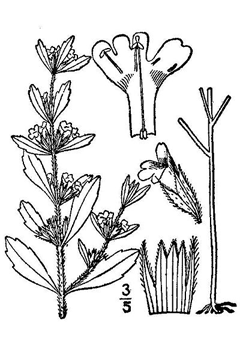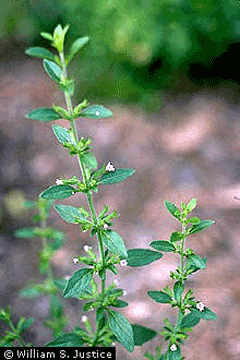 |
|
USDA Plant Database / Britton, N.L., and A. Brown. 1913. An illustrated flora of the northern United States, Canada and the British Possessions. Vol. 3: 136. Courtesy of Kentucky Native Plant Society |
 |
| William S. Justice @ USDA-NRCS PLANTS Database |
Translate this page:
Summary
Physical Characteristics

 Hedeoma pulegioides is a ANNUAL growing to 0.3 m (1ft) by 0.2 m (0ft 8in).
Hedeoma pulegioides is a ANNUAL growing to 0.3 m (1ft) by 0.2 m (0ft 8in).
See above for USDA hardiness. It is hardy to UK zone 6. It is in flower from July to September. The species is hermaphrodite (has both male and female organs).
Suitable for: light (sandy), medium (loamy) and heavy (clay) soils, prefers well-drained soil and can grow in nutritionally poor soil. Suitable pH: mildly acid and neutral soils and can grow in very acid soils.
It can grow in semi-shade (light woodland) or no shade. It prefers dry or moist soil.
UK Hardiness Map
US Hardiness Map
Synonyms
Plant Habitats
Woodland Garden Sunny Edge; Dappled Shade; Cultivated Beds;
Edible Uses
Edible Parts: Leaves
Edible Uses: Condiment
The leaves have a very strong mint-like aroma and taste[171], they can be brewed into a refreshing tea that promotes good digestion, or they can be used as a culinary flavouring[183, 238]. An essential oil from the plant is used by the food industry as a flavouring in beverages, ice cream, baked goods etc[183].
References More on Edible Uses
Medicinal Uses
Plants For A Future can not take any responsibility for any adverse effects from the use of plants. Always seek advice from a professional before using a plant medicinally.
Abortifacient Birthing aid Carminative Diaphoretic Rubefacient Stimulant
American pennyroyal has a long history of medicinal use by various native North American Indian tribes and has become a traditional household remedy in North America[238]. It is used mainly in the treatment of digestive disorders, colds, whooping cough, painful menstruation and as an aid in childbirth[238]. A tea made from the leaves or flowering stems is carminative, rubefacient, stimulant[46, 61, 171]. It is used to treat colds because it promotes perspiration[207]. A tea with brewers yeast can induce an abortion[213]. The plants are harvested when flowering and can be used fresh or dried[213, 238]. The essential oil is distilled from the plants when they are in flower and used medicinally in the same ways as the leaves. Caution is advised since the pure essential oil is very toxic and ingestion can be lethal whilst skin contact can cause dermatitis[222, 238].
References More on Medicinal Uses
The Bookshop: Edible Plant Books
Our Latest books on Perennial Plants For Food Forests and Permaculture Gardens in paperback or digital formats.

Edible Tropical Plants
Food Forest Plants for Hotter Conditions: 250+ Plants For Tropical Food Forests & Permaculture Gardens.
More

Edible Temperate Plants
Plants for Your Food Forest: 500 Plants for Temperate Food Forests & Permaculture Gardens.
More

More Books
PFAF have eight books available in paperback and digital formats. Browse the shop for more information.
Shop Now
Other Uses
Essential Repellent
The essential oil is used as an ingredient in commercial insect repellents and cleaning products[238]. The plant is used as an insect repellent[169, 171]. When rubbed on the body it is said to repel ticks[207].
Special Uses
Scented Plants
References More on Other Uses
Cultivation details
Prefers a sunny position in a well-drained acidic soil of low to moderate fertility[169]. Another report says that it prefers a rich sandy soil in sun or partial shade[238]. The plants neat habit and aromatic foliage make it a good candidate for growing in containers or planting near seats[238].
References Carbon Farming Information and Carbon Sequestration Information
Temperature Converter
Type a value in the Celsius field to convert the value to Fahrenheit:
Fahrenheit:
The PFAF Bookshop
Plants For A Future have a number of books available in paperback and digital form. Book titles include Edible Plants, Edible Perennials, Edible Trees,Edible Shrubs, Woodland Gardening, and Temperate Food Forest Plants. Our new book is Food Forest Plants For Hotter Conditions (Tropical and Sub-Tropical).
Shop Now
Plant Propagation
Seed - sow in situ in spring or autumn[169].
Other Names
If available other names are mentioned here
Native Range
NORTHERN AMERICA: Canada (Québec (south), Nova Scotia, Ontario (southeast), New Brunswick), United States (Connecticut, Indiana, Maine, Massachusetts, Michigan (south), New Hampshire, New Jersey, New York, Ohio, Pennsylvania, Rhode Island, Vermont, West Virginia, Illinois, Iowa, Kansas (east), Missouri, Oklahoma (northeast), Wisconsin, Alabama (north), Arkansas, Georgia (north), Kentucky, Maryland, North Carolina, South Carolina (northwest), Tennessee, Virginia)
Weed Potential
Right plant wrong place. We are currently updating this section.
Please note that a plant may be invasive in one area but may not in your area so it's worth checking.
Conservation Status
IUCN Red List of Threatened Plants Status :

Growth: S = slow M = medium F = fast. Soil: L = light (sandy) M = medium H = heavy (clay). pH: A = acid N = neutral B = basic (alkaline). Shade: F = full shade S = semi-shade N = no shade. Moisture: D = dry M = Moist We = wet Wa = water.
Now available:
Food Forest Plants for Mediterranean Conditions
350+ Perennial Plants For Mediterranean and Drier Food Forests and Permaculture Gardens.
[Paperback and eBook]
This is the third in Plants For A Future's series of plant guides for food forests tailored to
specific climate zones. Following volumes on temperate and tropical ecosystems, this book focuses
on species suited to Mediterranean conditions—regions with hot, dry summers and cool, wet winters,
often facing the added challenge of climate change.
Read More
Expert comment
Author
(L.)Pers.
Botanical References
43
Links / References
For a list of references used on this page please go here
Readers comment
© 2010, Plants For A Future. Plants For A Future is a charitable company limited by guarantee, registered in England and Wales. Charity No. 1057719, Company No. 3204567.